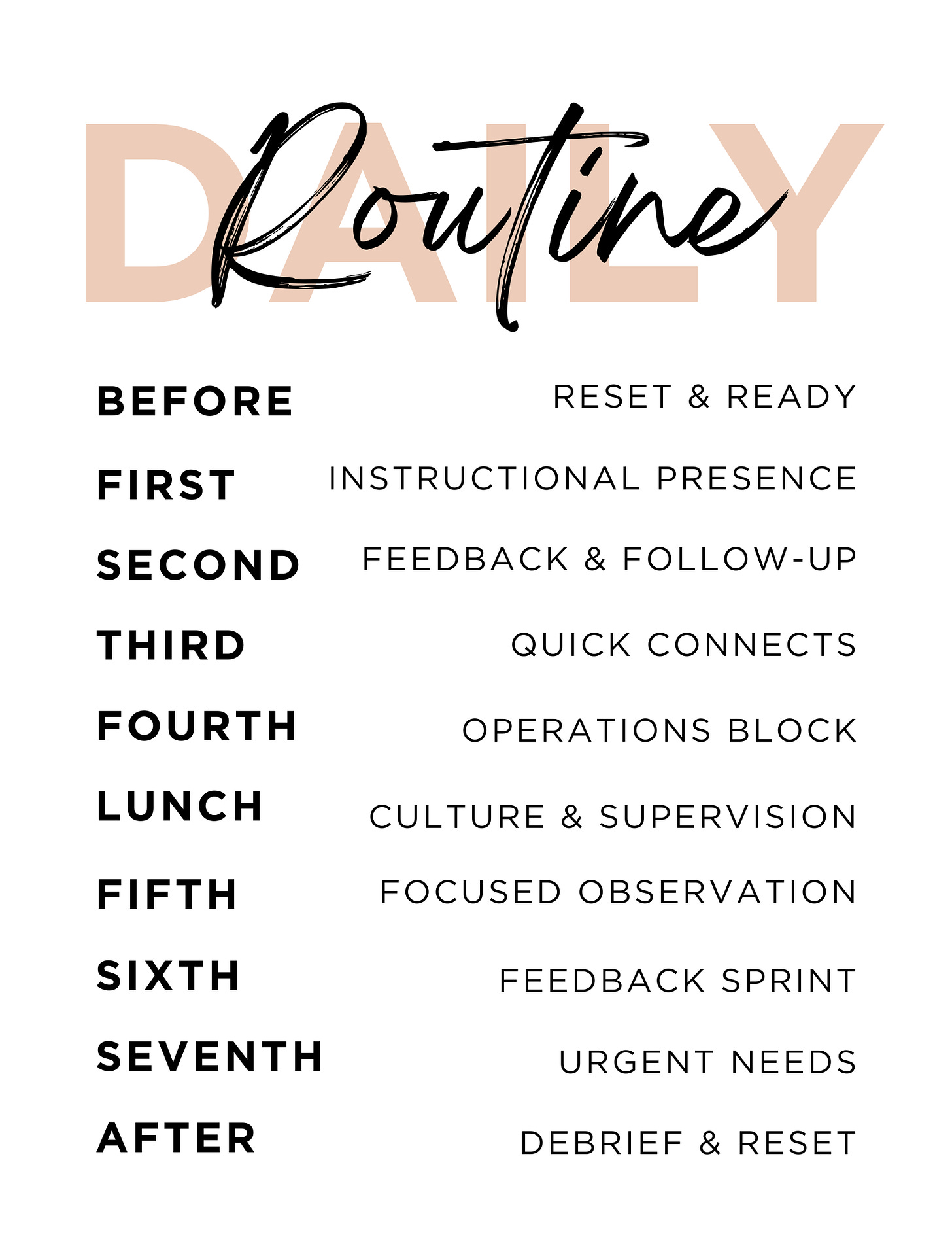Help! I have to work in 45-minute chunks and I'm getting nothing done
A daily routine that can help you get on track when things get off
Let’s be real: school leadership is a 12-tab job.
You start the day with a plan, and by third period, it’s buried under a mountain of supervision, student issues, last-minute coverage, lesson plans, and feedback you swore you were going to write yesterday.
For those of us who operate in schools with 7 periods and 45-minute chunks between hallway duty, it can feel nearly impossible to build rhythm into the chaos. But I’ve learned that a repeatable daily routine is less about perfection and more about intention. Here’s how to structure a day to stay instructional, operational, and human… all before the final bell rings.
Before School (30–45 min): Reset & Ready
Before the building fills with voices and questions, take 30 quiet minutes to get grounded:
Scan for coverage gaps or attendance red flags
Glance at the inbox—but only to spot fires (10 min max)
Choose the priority focus for the day
Station yourself at a high-traffic hallway spot to greet kids and catch the morning energy
It’s a tone-setter. Not just for others but for you.
Period-by-Period: The 7-Chunk Flow
Plan each period like it’s your instructional time. No more wondering “What should I be doing right now?”
Period 1: Instructional Presence
Drop into 2–3 classrooms for 5–7 minutes each. Looking for specific practices aligned with school-wide goals—student independent practice, warm-up routines, academic conversations. Take quick low-inference notes, snap a whiteboard photo, and stay long enough to understand, but short enough to stay nimble.
Period 2: Feedback + Quick Attendance Check
Use this time to log what you saw in Period 1, draft feedback, and follow up on lesson plan submissions or evaluation notes. If you don’t write it now, you probably won’t later. Do a quick attendance check to ensure the office staff is chasing absent students.
Period 3: Quick Connects
This is when you meet with a teacher, pop into a coach’s room, or have a 10-minute hallway conversation with a student who’s been flagged. It’s informal, but powerful. Relationship-building is a leadership strategy (in addition to just being a good human).
Period 4: Operations Block
The middle of the day is when you hit “admin mode.” Check sub coverage, discipline referrals, safety reports, and get paperwork off the desk. It’s also when you reply to central office emails you snoozed earlier.
Lunch + Passing Periods: Visible Leadership
Make your way to the cafeteria—not just for supervision, but to be seen. Fist bump, high-five, and check in with staff. You can’t underestimate the relational capital built over nuggets and nachos.
Period 5: Focused Observation
This is the deeper dive block. Do one full 20–30 minute observation or two targeted walkthroughs. Post-lunch periods often get less attention, but they deserve just as much instructional leadership.
Period 6: Feedback Sprint
Write feedback from Period 5 and/or praise publicly. One hallway shoutout, one staff email, one parent call. Try to lift up something good in the building every single day.
Period 7: Urgent Bucket + Wrap-Up
Save this block for the things that bubble up: a discipline issue, a parent callback, a quick reset conversation with a student. If it’s been a smooth day, use this block to review tomorrow’s coverage and prep my feedback notes.
After School (30–60 min): Finish Strong
The building empties, but try not to. Debrief with my leadership team, finalize observations, check the walk-through calendar, and ask myself:
“What’s the ONE thing I need to drive tomorrow?”
That clarity helps you close the laptop with intention.
Bonus: How To Keep This Sustainable
You’re not a robot. You won’t hit every period perfectly every day. But here are a few ways you can make this structure work over time:
Theme Each Day
Monday = vision & systemsTuesday = feedback
Wednesday = coaching
Thursday = student culture
Friday = celebration & reflection
Name Your Blocks
“Feedback Sprint,” “Drop Everything Block,” or “Walkthrough Watch” gives structure and stickiness to how you use time.Start with One Period
Commit to one period and devote whatever your thing is that you are NOT making time for. Communicate it clearly to others. I’m going to be off walkie during third hour this week to devote to classroom walkthroughs.
Work as a Team
Talk to each other. There are days when you may need deeper work blocks and can’t be present during passing period. Give folks a heads up so there’s still coverage and adult presence.
Color-Code the Calendar
Use a color for each focus—green for instruction, blue for ops, yellow for supervision—so you can see at a glance where your energy is going.
Final Thought
You don’t need to do everything every day. You need a rhythm you can return to when the day throws a curveball—and it always does.
A structured day doesn’t make the job easy. But it makes your impact visible—and your intentions clear and that’s a win worth planning for.



